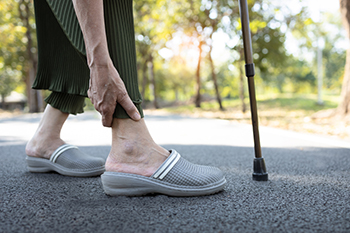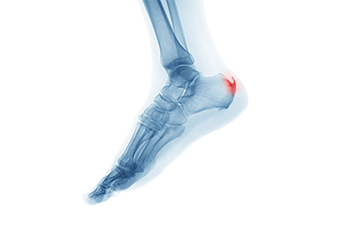Connect With Us
Blog
Items filtered by date: November 2022
Plantar Fibroma and Possible Causes

If you notice a growth in the arch of your foot, it may indicate a plantar fibroma has developed. This is a benign nodule and is found in the plantar fascia. This is the band of tissue on the sole of the foot that connects the heel to the toes. This fibroma grows slowly, generally less than one inch, yet it can cause the foot to ache. Research has possibly linked the cause of developing a plantar fibroma to genetic reasons and it may also be prevalent among the Northern European population. Additionally, there may be a connection between repeated foot injuries and the development of a plantar fibroma. People who have existing medical conditions like alcoholics, diabetic patients, and people with liver disease may be predisposed to this foot condition as well. There are various treatment methods for plantar fibroma and if you have pain in your arch, it is suggested that you consult with a podiatrist. This type of doctor can perform a diagnosis and offer the treatment technique that is right for you.
A plantar fibroma may disrupt your daily activities. If you have any concerns, contact Scott Matthews, DPM, MD of Salem Foot Care . Our doctor can provide the care you need to keep you pain-free and on your feet.
Plantar Fibroma
A plantar fibroma is a fibrous knot in the arch of the foot. It is embedded in the plantar fascia which is a band of tissue that extends from the heel to the toes along the bottom of the foot. There can be multiple plantar fibromas in the feet at the same time. There are no known causes for this condition. If you have a plantar fibroma, there will be a bump in the arch of your foot that cannot be missed. Any associated pain is most often due to a shoe rubbing against the nodule. Non-surgical options, such as steroid injections, physical therapy, and orthotics should be tried first. Surgery is a last resort and is the only thing that will remove a plantar fibroma entirely. Consult with a podiatrist for a proper diagnosis and to determine the treatment regimen that is right for you.
What Causes a Plantar Fibroma?
While there are no specific causes identified, a plantar fibroma can possibly come from genetic predisposition or the formation of scar tissue that forms from healing the tears in the plantar fascia.
What Are the Symptoms of a Plantar Fibroma?
There will be a noticeable lump in the arch of the foot that may or may not cause pain. If pain is felt, it is typically because a shoe is rubbing up against the lump or when walking or standing barefoot.
Treatment and Prevention
A plantar fibroma will not disappear without treatment, but it can get smaller and be a non-issue. If pain persists, a podiatrist examines the foot and when the arch of the foot is pressed, pain can be felt down to the toes. An MRI or biopsy might be performed to help diagnose or evaluate the plantar fibroma. The following non-surgical options are generally enough to reduce the size and pain of these nodules:
- Steroid injections
- Orthotics
- Physical therapy to help apply anti-inflammatory creams on the bump
Surgery is considered if the mass increases in size and the patient continues to feel pain after non-surgical methods are tried.
If you have any questions please feel free to contact our office located in Wikesboro, NC . We offer the newest diagnostic tools and technology to treat your foot and ankle needs.
Toenail Clippers for Seniors

Senior citizens can sometimes be more likely to develop afflictions of the foot than younger individuals. Therefore, it is especially important that seniors take extra special care to maintain the health of their feet. One of the ways in which this can be done is by trimming the nails correctly. Trimming the nails may be difficult for seniors because the nails can be difficult to reach. Some seniors, particularly those who are living with arthritis, may also struggle with being able to have a firm grip on the nail cutter. It is important to remember that one should not cut the nail too short, as this can lead to the development of an ingrown toenail. Additionally, the nail should be cut straight to prevent an ingrown toenail. If you are a senior, it is a good idea to make an appointment with a podiatrist today for more information.
Proper foot care is something many older adults forget to consider. If you have any concerns about your feet and ankles, contact Scott Matthews, DPM, MD from Salem Foot Care . Our doctor can provide the care you need to keep you pain-free and on your feet.
The Elderly and Their Feet
As we age we start to notice many changes in our body, but the elder population may not notice them right away. Medical conditions may prevent the elderly to take notice of their foot health right away. Poor vision is a lead contributor to not taking action for the elderly.
Common Conditions
- Neuropathy – can reduce feeling in the feet and can hide many life-threatening medical conditions.
- Reduced flexibility – prevents the ability of proper toenail trimming, and foot cleaning. If left untreated, it may lead to further medical issues.
- Foot sores – amongst the older population can be serious before they are discovered. Some of the problematic conditions they may face are:
- Gouging toenails affecting nearby toe
- Shoes that don’t fit properly
- Pressure sores
- Loss of circulation in legs & feet
- Edema & swelling of feet and ankles
Susceptible Infections
Diabetes and poor circulation can cause general loss of sensitivity over the years, turning a simple cut into a serious issue.
If you have any questions please feel free to contact our office located in Wikesboro, NC . We offer the newest diagnostic and treatment technologies for all your foot and ankle needs.
Active Children May Be Prone to Getting Sever’s Disease

Sever’s disease is a condition that affects children and young teenagers who participate in running and jumping activities. A noticeable symptom is heel pain, and this can occur when the muscles and tendons grow at different rates. Many parents may become aware of this foot condition when they notice their child is limping and complaining of heel pain. Relief is often sought at this time, despite the fact that children may outgrow this condition as the aging process occurs. Mild comfort may be found when the feet are rested as often as possible, in addition to wearing cushioned pads at the heel of the shoes. It is beneficial to temporarily stop the activity that caused this ailment, and replace it by performing specific stretches. An effective stretch is done by standing on a step, and lowering the heels one at a time until a gentle pull is felt. Sever’s disease can cause your child to have heel pain, and it is strongly urged that you consult a podiatrist who can help you and your child manage this condition.
Sever's disease often occurs in children and teens. If your child is experiencing foot or ankle pain, see Scott Matthews, DPM, MD from Salem Foot Care . Our doctor can treat your child’s foot and ankle needs.
Sever’s Disease
Sever’s disease is also known as calcaneal apophysitis, which is a medical condition that causes heel pain I none or both feet. The disease is known to affect children between the ages of 8 and 14.
Sever’s disease occurs when part of the child’s heel known as the growth plate (calcaneal epiphysis) is attached to the Achilles tendon. This area can suffer injury when the muscles and tendons of the growing foot do not keep pace with bone growth. Therefore, the constant pain which one experiences at the back of the heel will make the child unable to put any weight on the heel. The child is then forced to walk on their toes.
Symptoms
Acute pain – Pain associated with Sever’s disease is usually felt in the heel when the child engages in physical activity such as walking, jumping and or running.
Highly active – Children who are very active are among the most susceptible in experiencing Sever’s disease, because of the stress and tension placed on their feet.
If you have any questions, please feel free to contact our office located in Wikesboro, NC . We offer the newest diagnostic and treatment technologies for all your foot and ankle injuries.
How Can Diabetic Patients Check the Soles of Their Feet?

Diabetes is a serious condition and can lead to complications regarding the feet if not under the care of a podiatrist. Elevated blood sugar levels may lead to the inability to feel existing cuts on the feet. These can easily develop into foot ulcers and may be controlled by implementing healthy lifestyle habits. Drinking plenty of water daily, reducing sugar intake, and practicing a gentle exercise regime are a few ways that can guide the diabetic person to possibly feeling better. It is necessary to pay close attention to the feet, and the soles can be inspected daily by using a mirror. This is an effective method for noticing any cuts, bruises, or scrapes that have developed, and they may be easier to see than to feel. Good foot hygiene consists of trimming the toenails weekly, which is often performed by a podiatrist. Diabetic patients may notice the skin on their feet is excessively dry and cracked, which may indicate additional foot problems. If you have diabetes, it is strongly advised that you are under the care of a podiatrist who can treat this ailment, and help you manage it.
Diabetic foot care is important in preventing foot ailments such as ulcers. If you are suffering from diabetes or have any other concerns about your feet, contact Scott Matthews, DPM, MD from Salem Foot Care . Our doctor can provide the care you need to keep you pain-free and on your feet.
Diabetic Foot Care
Diabetes affects millions of people every year. The condition can damage blood vessels in many parts of the body, especially the feet. Because of this, taking care of your feet is essential if you have diabetes, and having a podiatrist help monitor your foot health is highly recommended.
The Importance of Caring for Your Feet
- Routinely inspect your feet for bruises or sores.
- Wear socks that fit your feet comfortably.
- Wear comfortable shoes that provide adequate support.
Patients with diabetes should have their doctor monitor their blood levels, as blood sugar levels play such a huge role in diabetic care. Monitoring these levels on a regular basis is highly advised.
It is always best to inform your healthcare professional of any concerns you may have regarding your feet, especially for diabetic patients. Early treatment and routine foot examinations are keys to maintaining proper health, especially because severe complications can arise if proper treatment is not applied.
If you have any questions please feel free to contact our office located in Wikesboro, NC . We offer the newest diagnostic and treatment technologies for all your foot and ankle needs.
Causes and Relief Tactics for Heel Spurs

Despite how small a heel spur can be, it is capable of causing severe pain and discomfort. It is defined as a bony protrusion that forms on the bottom of the heel, and can occur due to a heel injury. Additionally, it may occur from overuse while running, and this can cause the heel bone to undergo chronic stress. To compensate for this, the body’s natural defenses will form a bone that protrudes from the heel for protection. Many patients who have heel spurs experience little or no pain, and there are some people who have severe discomfort from a heel spur. This may be a result of an underlying condition that can affect the sole of the foot. An X-ray is often performed that can provide an accurate diagnosis, which can help to determine the severity of the heel spur. Mild relief may be found when lifestyle changes are implemented. These can include losing additional weight, wearing shoes that can accommodate the heel spur and are comfortable, and it may help to limit athletic activities. Surgery may be necessary for permanent relief. If you have developed a heel spur, please confer with a podiatrist who can help you to decide which treatment method is best for you.
Heel spurs can be incredibly painful and sometimes may make you unable to participate in physical activities. To get medical care for your heel spurs, contact Scott Matthews, DPM, MD from Salem Foot Care . Our doctor will do everything possible to treat your condition.
Heels Spurs
Heel spurs are formed by calcium deposits on the back of the foot where the heel is. This can also be caused by small fragments of bone breaking off one section of the foot, attaching onto the back of the foot. Heel spurs can also be bone growth on the back of the foot and may grow in the direction of the arch of the foot.
Older individuals usually suffer from heel spurs and pain sometimes intensifies with age. One of the main condition's spurs are related to is plantar fasciitis.
Pain
The pain associated with spurs is often because of weight placed on the feet. When someone is walking, their entire weight is concentrated on the feet. Bone spurs then have the tendency to affect other bones and tissues around the foot. As the pain continues, the feet will become tender and sensitive over time.
Treatments
There are many ways to treat heel spurs. If one is suffering from heel spurs in conjunction with pain, there are several methods for healing. Medication, surgery, and herbal care are some options.
If you have any questions feel free to contact our office located in Wikesboro, NC . We offer the latest in diagnostic and treatment technology to meet your needs.
Blog Archives
- April 2024
- March 2024
- February 2024
- January 2024
- December 2023
- November 2023
- October 2023
- September 2023
- August 2023
- July 2023
- June 2023
- May 2023
- April 2023
- March 2023
- February 2023
- January 2023
- December 2022
- November 2022
- October 2022
- September 2022
- August 2022
- July 2022
- June 2022
- May 2022
- April 2022
- March 2022
- February 2022
- January 2022
- December 2021
- November 2021
- October 2021
- September 2021
- August 2021
- July 2021
- June 2021
- May 2021
- April 2021
- March 2021
- February 2021
- January 2021
- December 2020
- November 2020
- October 2020
- September 2020
- August 2020
- July 2020
- June 2020
- May 2020
- April 2020
- March 2020
- February 2020
- January 2020
- December 2019
- November 2019
- October 2019
- September 2019
- August 2019
- July 2019
- June 2019
- May 2019
- April 2019
- March 2019
- February 2019
- January 2019
- December 2018
- November 2018
- October 2018
- September 2018
- August 2018
- July 2018
- June 2018
- May 2018

